Riverine Flotilla of the Polish Navy in 1939
Posted: May 7th, 2014, 9:42 pm
It has been a while since the last time I posted a ship. And seeing that battleship arms race going on here recently I decided to respond to it... with something completely different size-wise. 
(Pictures are below... waaay below - probably nobody will bother to read the text, but hey - it's my time, so I can waste it in any manner I want. )
)
Although not as well known as the seagoing part of the Polish Navy, Riverine Flotilla played a significant role in Poland's naval history. Already the Fourteen Points statement of the US president Woodrow Wilson (which was credited in convincing Germans to surrender in 1918) mentioned restitution of the independent Polish state with access to the sea, but actual transfer of the relevant part of the Baltic coastline from German to Polish control happened only well after the signing of the Treaty of Versailles, in January 1920. Therefore for more than a year, the nascent Polish Navy was actually limited to being a riverine formation.
First actions leading to creation of the Polish Navy were made already on 1 November 1918 (traditional date of regaining independence by Poland in 1918 is 11 November), in the very distant from the sea city of Kraków (in the Austrian-occupied areas), where local commander of Polish troops, gen. Bolesław Roja ordered mobilization of group of riverine ships and motor boats under command of cpt. Władysław Nawrocki. Few days later, in Warszawa (Warsaw), by the order of gen. Tadeusz Rozwadowski, local Polish troops took over German Wisla Flotilla (Weichsel-Flotille) and Militarized Shipping Group (Schiffahrtsgruppe). By mid-November, ships from Kraków and Warszawa were moved to Modlin (north of Warszawa), which became the main base of the navy in these early times.
Officialy the Polish Navy was formed on 28 November 1918 by decree of the Head of State, marshal Józef Piłsudski. It was headed by the Sekcja Marynarki Ministerstwa Spraw Wojskowych MSWojsk. (SM MSwojsk. Naval Section of the Ministry of Military Affairs) under colonel of the navy Bogumił Nowotny (until 1 February 1921 Polish Navy used army ranks with only "of the navy" added). Ships and craft obtained by navy thus far, were, however, transferred to the Ministry of Communications and only on 23rd December one steamship and 4 motor boats returned under military control, forming the nucleus of Flotylla Wiślana, FW (Wisła Flotilla). Throughout the 1919 took over several more steam ships and motor boats, and on 2 May 1919 SM MSWojsk. was replaced by Departament dla Spraw Morskich (DSM MSWojsk.) headed by rear-admiral Kazimierz Porębski (ex-Russian Navy). In the 1919 and early 1920 main task of FW was training of replacements for the second riverine flotilla (see below) and - in early 1920 - support of the regaining of Pomorze (Pomerania) coastal region, including Toruń, in which - despite it's distance from the sea - the main naval base and Naval School were established.
Second riverine flotilla of the Polish Navy - and it's first formation to took part in "shooting" war, was the Flotylla Pińska (FP, Pińsk Flotilla). It's origins lay in the capture of Pińsk by Polish troops on 5 March 1919. This city is centre of Polesie region with it's extensive Pripyat Marshes, characterized (even today, and far more nearly a century ago) by extremely poor road and rail network combined with many thousand of square kilometers of marshes and swamps - and relatively well developed network of waterways. Significance of Polesie region lays from it's near-impassability for any large modern army, creating a barrier effectively cutting the Eastern European theatre of operations in two between Bug river (on current Polish eastern border) to Dneper river (in central/eastern Ukraine).
Initially creation of the riverine force on Prypeć (Pripyat) was a result of dire logistical needs - area was captured on the eve of the spring thaw which practically cut off the Polish garrisons in the coutryside from Pińsk and supply lines to the rear. First craft of the FP, formally formed on 19 April 1919 and led by lieutenant Jan Giedroyć were 4 ex-German motor boats. Receding level of water allowed to move the boats from purely logistical to more combat operations - even more important due to arrival to the area of small detachment from Soviet Dnepr Flotilla. In the late May FP had it's first combat encounter with enemy ships near Mosty Wolańskie (Wolań Bridges - some 20 kilometers east from Pińsk). Several days later Polish aviation flew it's first anti-shipping mission when planes from Brześć-based 8 Eskadra Wywiadowcza attacked ships from Soviet flotilla. In the following months FP - strenghtened by single improvised armed ship (that was found to be unsuitable for combat and relegated to transport duties) and several boats, supported operations of the Polish land forces in the area and fought with much stronger Soviet Pripyat Flotilla (3 improvised monitors, 3 improvised gunboats and several motor boats). In late August it's base was moved eastwards to Dawidgródek, in September to Turów and in early October to Petryków (Pietrykau), only to return to Pińsk in November due to incoming winter (and expected freezing temperatures).
Shortly before the spring thaw in 1920, Polish land forces captured (on 7 March) important Soviet riverine base in Mozyrz (Mozyr), capturing there as much as 22 steamships, including 2 armored (improvised), 10 motor boats and 62 barges. This allowed a great strengthening of the FP, although severly limited by number of available personnel (and therefore very gradual).
By the late April 1920 Flotylla Pińska consisted of:
-Oddział Bojowy (Combat Detachment) - 1 armored ship, 3 armored boats, 3 armed boats, coastal artillery battery;
-Oddział Transportowy (Transport Detachment) - 9 transport ships and tugs, 18 barges;
-Warsztaty (Workshops) - 14 ships and 8 boats in refit and reserve.
At the same time Soviet Dnepr Flotilla had 18 armored and armed ships, 7 guardships, 4 minesweepers, 10 armored and armed boats and 48 auxiliaries.
So great disproportion in strength of opposing forces led FP to adapt an ambush tactics in which they tried to lure Soviet ships into the firing range of coastal battery.
On 25 April 1920 Polish and Ukrainian troops under joint command of marshal Piłsudski begun an offensive agains Soviet forces in Ukraine. FP supported the northern wing of Polish forces, advancing towards Czarnobyl (Chernobyl - yes, the very same), where it fought one of it's most important battles on 26-27 April, leading to the capture of town with 6 enemy ships (including 1 armed). On the first days of may, Flotilla (with the land forces it supported) reached Dnepr river and begun advance both up- and down-stream (towards Rzeczyca and Kiev respectively). Kiev itself was captured by Polish forces on 7 May 1920. Polish-Ukrainian advance divided the Soviet Dnepr Flotilla bottled up in 3 separate areas - on Berezina (in Bobruisk), upper Dnepr (in Homel) and lower Dnepr (in Yekaterinoslav). Polish success was short-lived, however. On 21 May Soviet Western Front under command of Mikhail Tukhachevsky started offensive on Belarus. On 26 May, South-Western Front under Aleksandr Yegorov begun offensive against overstretched Polish forces on Ukraine. On 5 June 1920 1st Cavalry Army (South-Western Front) under Semen Budenny broke through Polish front, causing Polish decision to begin a general retreat to the west on 16 June. Already on 11 June elements of Flotilla in Kiev were forced to scuttle their boats, followed by northern detachment in Łojew on 18 June, leaving mostly transport ships in Flotilla. Rapid Soviet advance - both north and south of Polesie - meant that FP would have to either scuttle their vessels or attempt to navigate the Kanał Królewski (Royal Channel) between Prypeć and Bug. Unfortunately low water levels meant that despite the last-minute attempts to deepen the channel most vessels of FP had to be scuttled already east of Pińsk - long before even reaching the channel. Remains of the FP reached Pińsk on 21 July, but upon hearing the news that water level in the Kanał Królewski dropped to 20 centimeters (8 inches), all units were scuttled and personnel and remaining materiel were sent by rail westwards. Pińsk fell to Soviet forces on 27 July and Flotylla Pińska was formally dissolved on 2 August 1920.
Although summer of 1920 brought the demise of Pińsk flotilla, it brought also a moment of glory for the Wisła flotilla. Due to Soviet advances it was hastily strenghtened by all available personnel and mobilized civilian wessels. On the 14 August 1920, eve of the decisive battle of Warsaw, it had 9 armed ships and 16 motor boats, with 4 more ships and several boats being added in the coming days. FW operated mostly in the aread north of Warszawa, between Wyszogród and Włocławek (with occasional patrols southwards). It successfuly fought agains attempts of Soviet III Cavalry Corps under Gai Bzhishkyan to cross the river at Bobrowniki, Dobrzyń nad Wisłą and especially Płock which was on the main line of Soviet assault attempting to encircle Warszawa from the north. Altogether, before the Soviet forces were defeated and forced into disorderly retreat, FW lost 3 ships but played a major role on the northern wing of Polish troops.
In the final months of Polish-Soviet war and first months of peace FW - based in Toruń - was Poland's only riverine flotilla. It was greatly strenghtened by 4 monitors built in Gdańsk, that entered service in late 1920. Gradually a detachment on Prypeć was formed, allowing the gradual re-creation of Flotylla Pińska (with some of it's 1920 ships being raised and repaired). Early 1920s plans called for total of 3 riverine flotillas - one each on Wisła, Prypeć and Niemen. But fiscal constraints allowed for creation of only two of them, and further economical troubles led to disbandment of the FW and transfer of all it's assets to Pińsk flotilla - thereby renamed Flotylla Rzeczna Marynarki Wojennej (FR MW, Riverine Flotilla of the Navy). During the 1920s and 1930s FP acquired new ships and boats (both really new and ex-civilian vessels of various origins) and even an aviation squadron.
Threat of new war, against Germany in 1939 lead to creation of the Oddział Wydzielony Wisła (OW-Wisła, Detachment Wisła) from the elements of the FR MW with 5 armed cutters (including one heavy), 2 liaison cutters and one "staff ship", based in Brdyujście (today part of Bydgoszcz) and subordinated to the Armia Pomorze (Pomorze Army). OW-Wisła took part in operations agains advancind German forces until low levels of water in Wisła forced scuttling of all it's ships except one near Płock on 10 September. Main force of the FR MW remained in Pińsk where it was reached by the news of Soviet agression on 17 September 1939. General situation forced scuttling of ships until 20/21 September, while the personnel of Flotilla joined Polish land units operating in the area - and later ended up either in German or Soviet captivity (in which over a hundred of them were later murdered). In the following months some of flotilla's ships were raised and repaired by Soviets, although their service under red banner wasn't particularly long as they were lost again during German invasion of Russia in 1941.
It should be noted that sources for the pre-war Polish Navy are relatively scarce as many were lost in 1939. It is particularly significant in relation to the Riverine Flotilla that unlike the seagoing part of the navy, had no chance to evade destruction (including loss of documents). As You can see, exact shape of underwater hulls of smaller vessels is generally unknown. Another issue is that length of many vessels is given in many sources, but very rarely it is known wether it's refers to total measurement, on the waterline or between perpendiculars. Therefore I had to take a number of assumptions - which could be wrong.
Monitors
Warszawa class monitors were ordered in 1919 in Gdańsk (by then Free City under the protectorate of League of Nations) and delivered in late 1920. Armed with three 75mm guns in two turrets (two in bow turret, one in aft turret) and several machine guns (number varied due to modifications - usually four). In late 1939 they underwent various modifications to the superstructure (although chronological details of these are somewhat blurry). All four were scuttled on 18 September 1939 (Warszawa was already immobile since 8-9 september when it ran on a sandbank). Later they were raised by Soviets and renamed (Warszawa to Vitebsk, Toruń to Vinnitsa, Horodyszcze to Bobruisk and Pińsk to Zhitomir). They were all lost between late August and 19 September 1941.
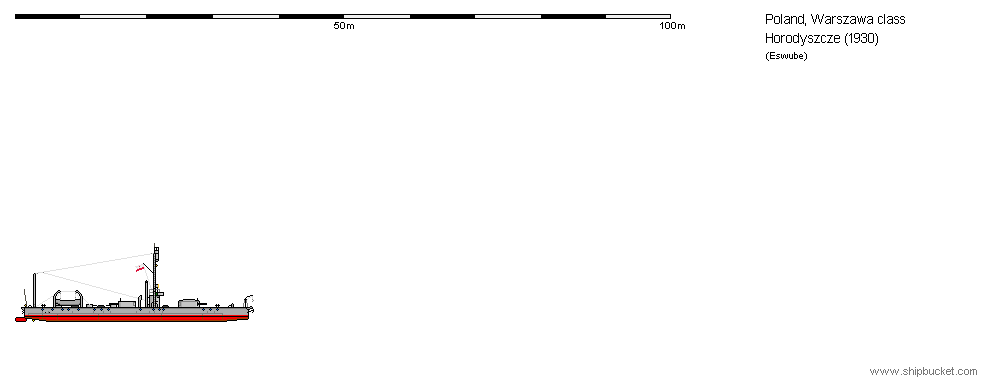

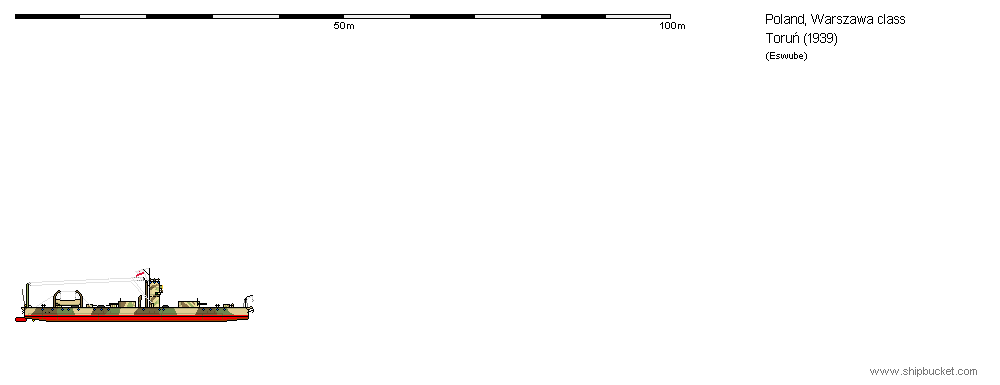
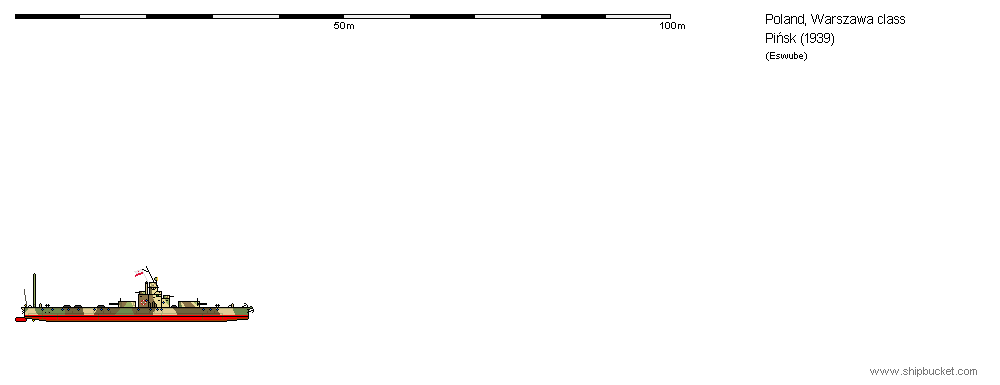
Kraków class monitors were built 1924-1926 by Stocznia Zieleniewskiego (Zieleniewski's Shipyard) in Kraków. Armed with 3 100mm howitzers in two turrets and 2-4 machine guns. Wilno was blown up by its crew on 18 September 1939 and Kraków scuttled on 20 or 21 September 1939, later to be raised by Soviets, renamed Smolensk and lost again in combat on 11 September 1941.
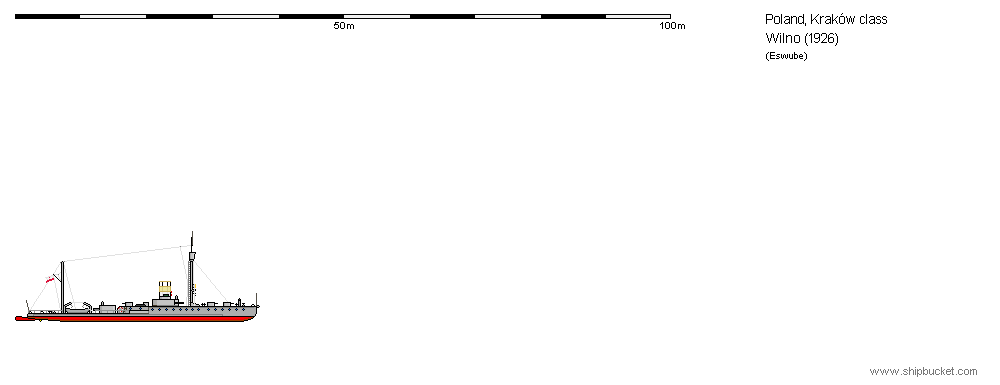
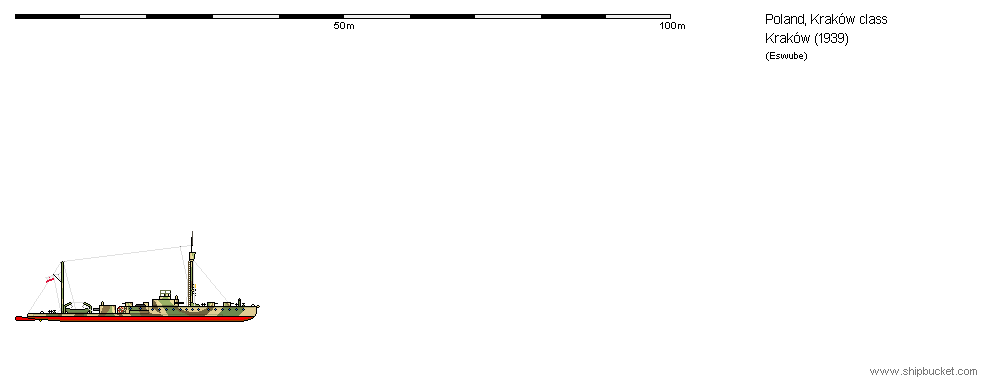
Gunboats and Armed Ships
Z or Zuchwała class gunboats (Zuchwała - Daring, Zawzięta - Fierce, Zaradna - Resourceful - all in female gender forms) were small gunboats built 1932-1933 in Pińsk, with main armament being 100mm howitzer in turret. Apparently Zaradna had retractable observation tower, but there are no details about it's appearance. All three were scuttled on 19 September 1939. Zaradna was later raised by Soviets, used in combat in summer 1941 and captured (damaged) by Germans on 18 September 1941 and repaired. On 5 April 1942 it ran aground in Kanał Królewski and was later heavily damaged by Polish guerillas. Towed back to Pińsk by Germans, it was scrapped there shortly after.

Admirał Dickman (named after Arend Dijckmann (1572-1627) - Dutch captain who lived in Gdańsk since 1608, and on 28 November 1627 led the - somewhat improvised - Polish fleet in the victorious battle of Oliwa against Swedish fleet, although at a cost of his own life) was built as riverine tugboat Todleben and was based on Prypeć, when it was pressed into service in Soviet fleet. Captured by Poles in 1920, was renamed Leon. Scuttled and raised 1920-1921, it served until 1935 as armed ship until around 1935 was adapted as air-defence ship, serving in that capacity until 1937 when it was turned into target ship. In 1939 it was repainted to cover damage, equipped with false armament, located on sandbank and used as decoy to lure the attention of German aircraft away from the actual ships.
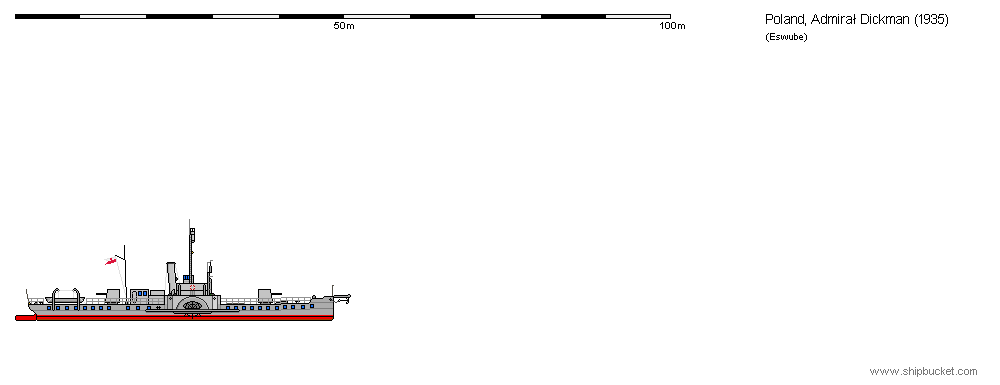
Generał Sikorski (named after Władysław Sikorski (1881-1943) - one of the more significant Polish generals of the inter-war era, prime minister 1922-1923 and later prime minister in exile and commander-in-chief 1939-1943) was a small passenger ship "Pereval", pressed into Soviet service after the Revolution and captured by Polish forces in 1920, renamed Pułkownik Sikorski (Colonel Sikorski - referring to his rank at the time, when leading one of the Polish divisions in Pińsk aread). Later scuttled and raised 1920-1921, "promoted" with it's namesake, initally used as staff ship, but later converted to more combat role, from some point used as air-defence ship. Scuttled again on 18 September 1939, raised by Soviets and used as staff ship Bug until summer 1941.
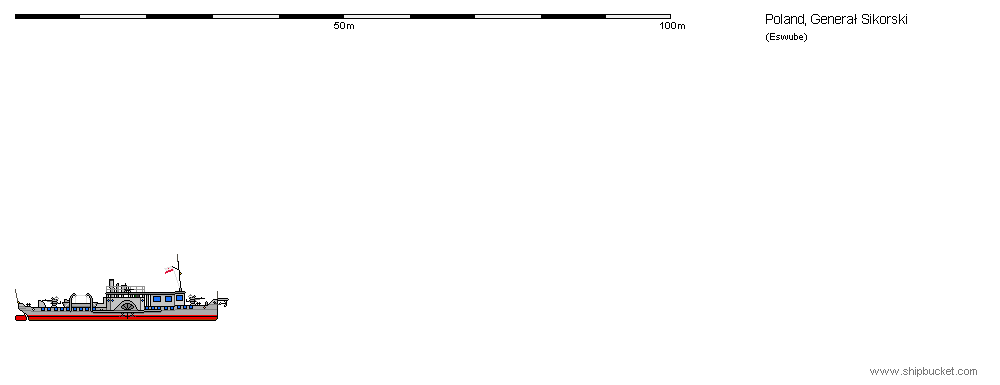
Generał Szeptycki (named after Stanisław Szeptycki (1867-1950) - one of the more significant Polish generals of the inter-war era) was an ex-Russian riverine merchant ship Desna, in 1919 pressed into Soviet service (as Zvyagel later changed to Golovnoy), captured by Polish forces in 1920. Later scuttled and raised 1920-1921. Served initially as mine ship, but after Mątwa (below) entered service it was modified as armed ship. Scuttled on 18 September 1939, raised by Soviets and renamed Nyeman, sunk again in 1941.
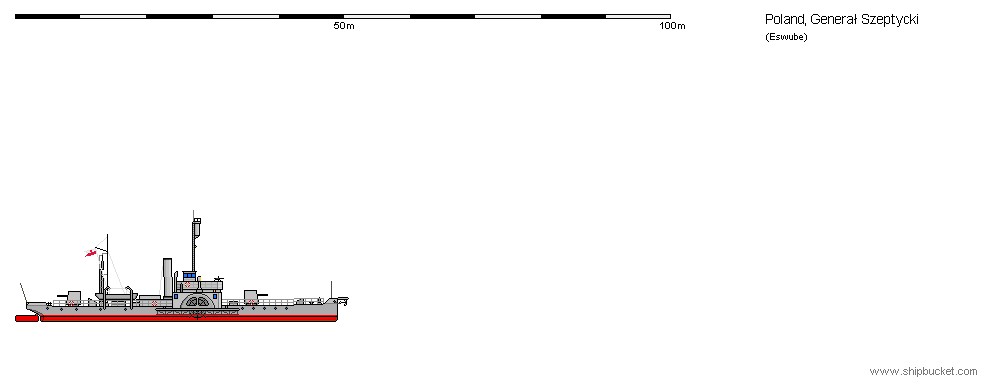
Hetman Chodkiewicz (named after Jan Karol Chodkiewicz (1560-1621) - one of the greatest Polish military commanders and most significant European military commanders of early 17th century) was an ex-Russian tug Buzhyn, used by Soviets, captured in 1920 by Poles, scuttled and raised 1920-1921, in 1933 it was adapted for air defence role. In September 1939 it shot down 3 or 4 German aircraft. Scuttled on 17 September 1939, it was raised by Soviets and used as floating base Berezina. In that capacity it was sunk by German aircaft in June 1941.
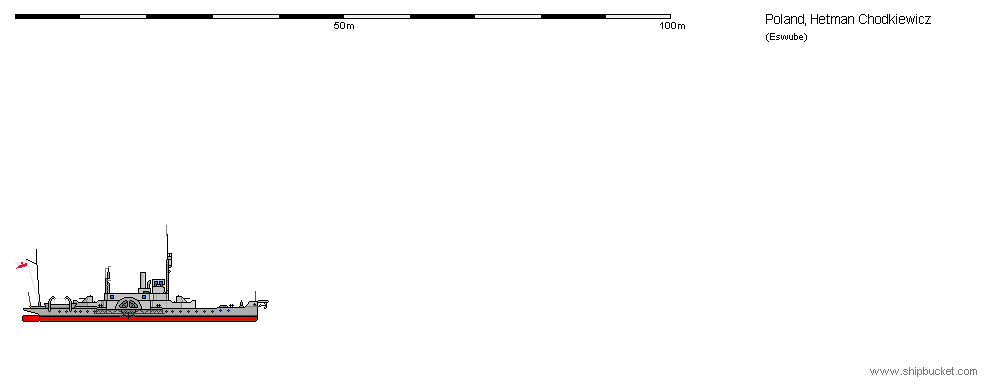
Armed Cutters
KU-1 class (Kuter Uzbrojony - Armed Cutter) consisted of 3 boats made around 1918 by Austriawerft in Linz and purchased in 1919 by Poland.
KU-4 class were larger sisters of KU-1 class, purchased from the same source. In 1939 they were part of OW-Wisła.
KU-6 was a scout and communications cutter with lightly armored superstructure. In 1939 it was part of OW-Wisła.
KU-7 was a scout and communications cutter with lightly armored superstructure.
KU-16 class consisted of 4 boats with lightly armored superstructure and turred adapted from the Wz.29 armored car.
KU-21 class were 4 small boats made by Erste Böhmisch-Mährische Maschinenfabrik in Prague, used mostly for auxliary duties.
KU-25 class were 5 boats with lightly armored superstructure and turred adapted from the Wz.29 armored car.
KU-30 was a fast armored cutter built in 1936-1939 in Modlin. In 1939 it was part of OW-Wisła and it was the only craft of that unit that avoided scuttling on 10 September, though was later scuttled in Modlin.

CKU Nieuchwytny (Ciężki Kuter Uzbrojony "Nieuchwytny - Heavy Armed Cutter "Uncatchable) was a relatively large armored boat built 1932-1934 in Modlin. In 1939 it was part of OW-Wisła. Apparently it was raised and used by Germans until scuttled again in 1944. Then it was re-raised and between ca. 1945 and 1957 used by Coast Guard as Okoń (Perch; although I don't know any sources showing it's appearance in that period).
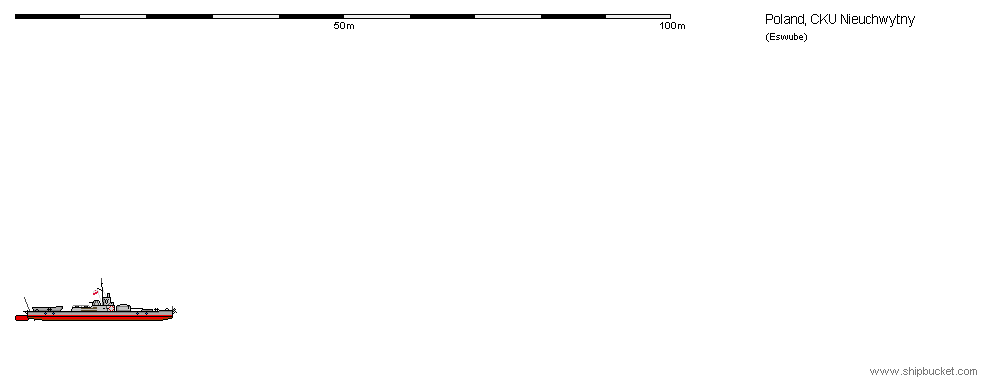
Mine Warfare and Liaison Vessels
Statek Minowy Mątwa or Statek Minowo-Gazowy Mątwa (Mine-Gas Ship "Cuttlefish" - note: in Polish "statek" refers to civilian vessel, military vessels are usually called "okręt") was initially an accomodation barge captured by Polish troops in 1920. It was scuttled during the summer retreat in 1920, but later raised and repaired. In 1925 it was equipped with engine and equipped for minelaying (up to 160 small mines). It was a flagship of the flotillas mine warfare squadron. Scuttled again on 18 September 1939 it was raised by Soviets and used as minelayer on Dneper until sunk by German tank fire on 27 August 1941.

KM-8 was small liaison cutter.
KM-12 class were 4 armed liaison cutters built around 1930 in Pińsk.
T-1 class were three armored riverine minesweepers built in 1935 in Pińsk.
T-4 class (initially T-1 class until renamed when the armored minesweepers entered service) were small paddleboat minesweeping boats built 1927-1930 in Pińsk.

Special Vessels (select)
Admirał Sierpinek (named after first Polish admiral, Mateusz Sierpinek, living in 16th century) was a former Russian civilian ship Tatiana, captured by Polish forces in Czarnobyl in 1920. Later scuttled and raised, it served on Wisła as training ship until in 1929 it became a "staff ship". Scuttled already on 17 September 1939, was raised by Soviets and used as staff ship Pripyat.
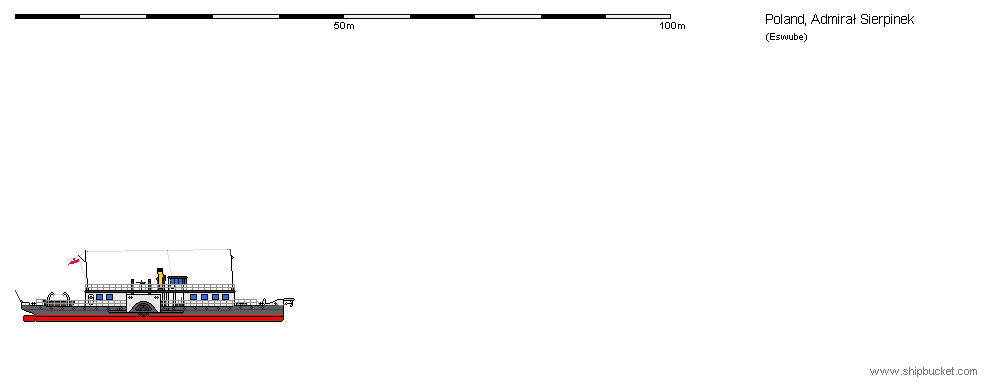
Generał Sosnkowski (named after Kazimierz Sosnkowski (1885-1969) one of the more significant Polish generals of the inter-war era and later commander-in-chief of the Polish Forces in Great Britain 1943-1944) was an ex-Russian ship Pritky, used by Soviets as improvised gunboat and captured by Polish forces in 1920. Scuttled and raised 1920-1921, it served as gunboat on Prypeć until 1927, when it was transferred to Gdynia where it served as (seagoing!) training ship of the torpedo and mine specialists (armed with trainable torpedo launcher and mine rails) until 1930 when it returned to Pińsk and was converted to hospital ship. It was scuttled on 17 September 1939, raised by Soviets, used as hospital ship until 6 September 1941 when it was again scuttled but raised in 1944 and again pressed into service.
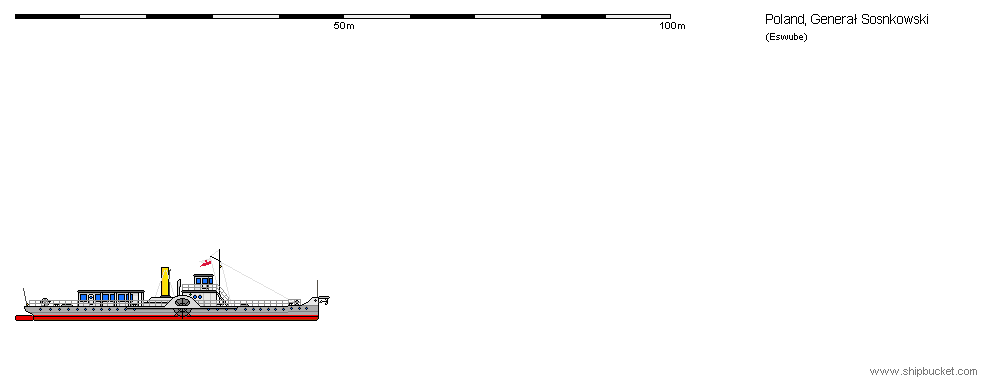
In 1939 Polish riverine flotilla had one more staff ship: Hetman Żółkiewski but unfortunately of the two sources giving the drawings of this ship one shows clearly wrong ship, another clearly wrong dimensions (which seem rather fit to the first ship).
Additionaly flotilla had a number of smaller auxilairy vessels, including numerous barges, boats and small tugs.
(Pictures are below... waaay below - probably nobody will bother to read the text, but hey - it's my time, so I can waste it in any manner I want.
Although not as well known as the seagoing part of the Polish Navy, Riverine Flotilla played a significant role in Poland's naval history. Already the Fourteen Points statement of the US president Woodrow Wilson (which was credited in convincing Germans to surrender in 1918) mentioned restitution of the independent Polish state with access to the sea, but actual transfer of the relevant part of the Baltic coastline from German to Polish control happened only well after the signing of the Treaty of Versailles, in January 1920. Therefore for more than a year, the nascent Polish Navy was actually limited to being a riverine formation.
First actions leading to creation of the Polish Navy were made already on 1 November 1918 (traditional date of regaining independence by Poland in 1918 is 11 November), in the very distant from the sea city of Kraków (in the Austrian-occupied areas), where local commander of Polish troops, gen. Bolesław Roja ordered mobilization of group of riverine ships and motor boats under command of cpt. Władysław Nawrocki. Few days later, in Warszawa (Warsaw), by the order of gen. Tadeusz Rozwadowski, local Polish troops took over German Wisla Flotilla (Weichsel-Flotille) and Militarized Shipping Group (Schiffahrtsgruppe). By mid-November, ships from Kraków and Warszawa were moved to Modlin (north of Warszawa), which became the main base of the navy in these early times.
Officialy the Polish Navy was formed on 28 November 1918 by decree of the Head of State, marshal Józef Piłsudski. It was headed by the Sekcja Marynarki Ministerstwa Spraw Wojskowych MSWojsk. (SM MSwojsk. Naval Section of the Ministry of Military Affairs) under colonel of the navy Bogumił Nowotny (until 1 February 1921 Polish Navy used army ranks with only "of the navy" added). Ships and craft obtained by navy thus far, were, however, transferred to the Ministry of Communications and only on 23rd December one steamship and 4 motor boats returned under military control, forming the nucleus of Flotylla Wiślana, FW (Wisła Flotilla). Throughout the 1919 took over several more steam ships and motor boats, and on 2 May 1919 SM MSWojsk. was replaced by Departament dla Spraw Morskich (DSM MSWojsk.) headed by rear-admiral Kazimierz Porębski (ex-Russian Navy). In the 1919 and early 1920 main task of FW was training of replacements for the second riverine flotilla (see below) and - in early 1920 - support of the regaining of Pomorze (Pomerania) coastal region, including Toruń, in which - despite it's distance from the sea - the main naval base and Naval School were established.
Second riverine flotilla of the Polish Navy - and it's first formation to took part in "shooting" war, was the Flotylla Pińska (FP, Pińsk Flotilla). It's origins lay in the capture of Pińsk by Polish troops on 5 March 1919. This city is centre of Polesie region with it's extensive Pripyat Marshes, characterized (even today, and far more nearly a century ago) by extremely poor road and rail network combined with many thousand of square kilometers of marshes and swamps - and relatively well developed network of waterways. Significance of Polesie region lays from it's near-impassability for any large modern army, creating a barrier effectively cutting the Eastern European theatre of operations in two between Bug river (on current Polish eastern border) to Dneper river (in central/eastern Ukraine).
Initially creation of the riverine force on Prypeć (Pripyat) was a result of dire logistical needs - area was captured on the eve of the spring thaw which practically cut off the Polish garrisons in the coutryside from Pińsk and supply lines to the rear. First craft of the FP, formally formed on 19 April 1919 and led by lieutenant Jan Giedroyć were 4 ex-German motor boats. Receding level of water allowed to move the boats from purely logistical to more combat operations - even more important due to arrival to the area of small detachment from Soviet Dnepr Flotilla. In the late May FP had it's first combat encounter with enemy ships near Mosty Wolańskie (Wolań Bridges - some 20 kilometers east from Pińsk). Several days later Polish aviation flew it's first anti-shipping mission when planes from Brześć-based 8 Eskadra Wywiadowcza attacked ships from Soviet flotilla. In the following months FP - strenghtened by single improvised armed ship (that was found to be unsuitable for combat and relegated to transport duties) and several boats, supported operations of the Polish land forces in the area and fought with much stronger Soviet Pripyat Flotilla (3 improvised monitors, 3 improvised gunboats and several motor boats). In late August it's base was moved eastwards to Dawidgródek, in September to Turów and in early October to Petryków (Pietrykau), only to return to Pińsk in November due to incoming winter (and expected freezing temperatures).
Shortly before the spring thaw in 1920, Polish land forces captured (on 7 March) important Soviet riverine base in Mozyrz (Mozyr), capturing there as much as 22 steamships, including 2 armored (improvised), 10 motor boats and 62 barges. This allowed a great strengthening of the FP, although severly limited by number of available personnel (and therefore very gradual).
By the late April 1920 Flotylla Pińska consisted of:
-Oddział Bojowy (Combat Detachment) - 1 armored ship, 3 armored boats, 3 armed boats, coastal artillery battery;
-Oddział Transportowy (Transport Detachment) - 9 transport ships and tugs, 18 barges;
-Warsztaty (Workshops) - 14 ships and 8 boats in refit and reserve.
At the same time Soviet Dnepr Flotilla had 18 armored and armed ships, 7 guardships, 4 minesweepers, 10 armored and armed boats and 48 auxiliaries.
So great disproportion in strength of opposing forces led FP to adapt an ambush tactics in which they tried to lure Soviet ships into the firing range of coastal battery.
On 25 April 1920 Polish and Ukrainian troops under joint command of marshal Piłsudski begun an offensive agains Soviet forces in Ukraine. FP supported the northern wing of Polish forces, advancing towards Czarnobyl (Chernobyl - yes, the very same), where it fought one of it's most important battles on 26-27 April, leading to the capture of town with 6 enemy ships (including 1 armed). On the first days of may, Flotilla (with the land forces it supported) reached Dnepr river and begun advance both up- and down-stream (towards Rzeczyca and Kiev respectively). Kiev itself was captured by Polish forces on 7 May 1920. Polish-Ukrainian advance divided the Soviet Dnepr Flotilla bottled up in 3 separate areas - on Berezina (in Bobruisk), upper Dnepr (in Homel) and lower Dnepr (in Yekaterinoslav). Polish success was short-lived, however. On 21 May Soviet Western Front under command of Mikhail Tukhachevsky started offensive on Belarus. On 26 May, South-Western Front under Aleksandr Yegorov begun offensive against overstretched Polish forces on Ukraine. On 5 June 1920 1st Cavalry Army (South-Western Front) under Semen Budenny broke through Polish front, causing Polish decision to begin a general retreat to the west on 16 June. Already on 11 June elements of Flotilla in Kiev were forced to scuttle their boats, followed by northern detachment in Łojew on 18 June, leaving mostly transport ships in Flotilla. Rapid Soviet advance - both north and south of Polesie - meant that FP would have to either scuttle their vessels or attempt to navigate the Kanał Królewski (Royal Channel) between Prypeć and Bug. Unfortunately low water levels meant that despite the last-minute attempts to deepen the channel most vessels of FP had to be scuttled already east of Pińsk - long before even reaching the channel. Remains of the FP reached Pińsk on 21 July, but upon hearing the news that water level in the Kanał Królewski dropped to 20 centimeters (8 inches), all units were scuttled and personnel and remaining materiel were sent by rail westwards. Pińsk fell to Soviet forces on 27 July and Flotylla Pińska was formally dissolved on 2 August 1920.
Although summer of 1920 brought the demise of Pińsk flotilla, it brought also a moment of glory for the Wisła flotilla. Due to Soviet advances it was hastily strenghtened by all available personnel and mobilized civilian wessels. On the 14 August 1920, eve of the decisive battle of Warsaw, it had 9 armed ships and 16 motor boats, with 4 more ships and several boats being added in the coming days. FW operated mostly in the aread north of Warszawa, between Wyszogród and Włocławek (with occasional patrols southwards). It successfuly fought agains attempts of Soviet III Cavalry Corps under Gai Bzhishkyan to cross the river at Bobrowniki, Dobrzyń nad Wisłą and especially Płock which was on the main line of Soviet assault attempting to encircle Warszawa from the north. Altogether, before the Soviet forces were defeated and forced into disorderly retreat, FW lost 3 ships but played a major role on the northern wing of Polish troops.
In the final months of Polish-Soviet war and first months of peace FW - based in Toruń - was Poland's only riverine flotilla. It was greatly strenghtened by 4 monitors built in Gdańsk, that entered service in late 1920. Gradually a detachment on Prypeć was formed, allowing the gradual re-creation of Flotylla Pińska (with some of it's 1920 ships being raised and repaired). Early 1920s plans called for total of 3 riverine flotillas - one each on Wisła, Prypeć and Niemen. But fiscal constraints allowed for creation of only two of them, and further economical troubles led to disbandment of the FW and transfer of all it's assets to Pińsk flotilla - thereby renamed Flotylla Rzeczna Marynarki Wojennej (FR MW, Riverine Flotilla of the Navy). During the 1920s and 1930s FP acquired new ships and boats (both really new and ex-civilian vessels of various origins) and even an aviation squadron.
Threat of new war, against Germany in 1939 lead to creation of the Oddział Wydzielony Wisła (OW-Wisła, Detachment Wisła) from the elements of the FR MW with 5 armed cutters (including one heavy), 2 liaison cutters and one "staff ship", based in Brdyujście (today part of Bydgoszcz) and subordinated to the Armia Pomorze (Pomorze Army). OW-Wisła took part in operations agains advancind German forces until low levels of water in Wisła forced scuttling of all it's ships except one near Płock on 10 September. Main force of the FR MW remained in Pińsk where it was reached by the news of Soviet agression on 17 September 1939. General situation forced scuttling of ships until 20/21 September, while the personnel of Flotilla joined Polish land units operating in the area - and later ended up either in German or Soviet captivity (in which over a hundred of them were later murdered). In the following months some of flotilla's ships were raised and repaired by Soviets, although their service under red banner wasn't particularly long as they were lost again during German invasion of Russia in 1941.
It should be noted that sources for the pre-war Polish Navy are relatively scarce as many were lost in 1939. It is particularly significant in relation to the Riverine Flotilla that unlike the seagoing part of the navy, had no chance to evade destruction (including loss of documents). As You can see, exact shape of underwater hulls of smaller vessels is generally unknown. Another issue is that length of many vessels is given in many sources, but very rarely it is known wether it's refers to total measurement, on the waterline or between perpendiculars. Therefore I had to take a number of assumptions - which could be wrong.
Monitors
Warszawa class monitors were ordered in 1919 in Gdańsk (by then Free City under the protectorate of League of Nations) and delivered in late 1920. Armed with three 75mm guns in two turrets (two in bow turret, one in aft turret) and several machine guns (number varied due to modifications - usually four). In late 1939 they underwent various modifications to the superstructure (although chronological details of these are somewhat blurry). All four were scuttled on 18 September 1939 (Warszawa was already immobile since 8-9 september when it ran on a sandbank). Later they were raised by Soviets and renamed (Warszawa to Vitebsk, Toruń to Vinnitsa, Horodyszcze to Bobruisk and Pińsk to Zhitomir). They were all lost between late August and 19 September 1941.




Kraków class monitors were built 1924-1926 by Stocznia Zieleniewskiego (Zieleniewski's Shipyard) in Kraków. Armed with 3 100mm howitzers in two turrets and 2-4 machine guns. Wilno was blown up by its crew on 18 September 1939 and Kraków scuttled on 20 or 21 September 1939, later to be raised by Soviets, renamed Smolensk and lost again in combat on 11 September 1941.


Gunboats and Armed Ships
Z or Zuchwała class gunboats (Zuchwała - Daring, Zawzięta - Fierce, Zaradna - Resourceful - all in female gender forms) were small gunboats built 1932-1933 in Pińsk, with main armament being 100mm howitzer in turret. Apparently Zaradna had retractable observation tower, but there are no details about it's appearance. All three were scuttled on 19 September 1939. Zaradna was later raised by Soviets, used in combat in summer 1941 and captured (damaged) by Germans on 18 September 1941 and repaired. On 5 April 1942 it ran aground in Kanał Królewski and was later heavily damaged by Polish guerillas. Towed back to Pińsk by Germans, it was scrapped there shortly after.

Admirał Dickman (named after Arend Dijckmann (1572-1627) - Dutch captain who lived in Gdańsk since 1608, and on 28 November 1627 led the - somewhat improvised - Polish fleet in the victorious battle of Oliwa against Swedish fleet, although at a cost of his own life) was built as riverine tugboat Todleben and was based on Prypeć, when it was pressed into service in Soviet fleet. Captured by Poles in 1920, was renamed Leon. Scuttled and raised 1920-1921, it served until 1935 as armed ship until around 1935 was adapted as air-defence ship, serving in that capacity until 1937 when it was turned into target ship. In 1939 it was repainted to cover damage, equipped with false armament, located on sandbank and used as decoy to lure the attention of German aircraft away from the actual ships.

Generał Sikorski (named after Władysław Sikorski (1881-1943) - one of the more significant Polish generals of the inter-war era, prime minister 1922-1923 and later prime minister in exile and commander-in-chief 1939-1943) was a small passenger ship "Pereval", pressed into Soviet service after the Revolution and captured by Polish forces in 1920, renamed Pułkownik Sikorski (Colonel Sikorski - referring to his rank at the time, when leading one of the Polish divisions in Pińsk aread). Later scuttled and raised 1920-1921, "promoted" with it's namesake, initally used as staff ship, but later converted to more combat role, from some point used as air-defence ship. Scuttled again on 18 September 1939, raised by Soviets and used as staff ship Bug until summer 1941.

Generał Szeptycki (named after Stanisław Szeptycki (1867-1950) - one of the more significant Polish generals of the inter-war era) was an ex-Russian riverine merchant ship Desna, in 1919 pressed into Soviet service (as Zvyagel later changed to Golovnoy), captured by Polish forces in 1920. Later scuttled and raised 1920-1921. Served initially as mine ship, but after Mątwa (below) entered service it was modified as armed ship. Scuttled on 18 September 1939, raised by Soviets and renamed Nyeman, sunk again in 1941.

Hetman Chodkiewicz (named after Jan Karol Chodkiewicz (1560-1621) - one of the greatest Polish military commanders and most significant European military commanders of early 17th century) was an ex-Russian tug Buzhyn, used by Soviets, captured in 1920 by Poles, scuttled and raised 1920-1921, in 1933 it was adapted for air defence role. In September 1939 it shot down 3 or 4 German aircraft. Scuttled on 17 September 1939, it was raised by Soviets and used as floating base Berezina. In that capacity it was sunk by German aircaft in June 1941.

Armed Cutters
KU-1 class (Kuter Uzbrojony - Armed Cutter) consisted of 3 boats made around 1918 by Austriawerft in Linz and purchased in 1919 by Poland.
KU-4 class were larger sisters of KU-1 class, purchased from the same source. In 1939 they were part of OW-Wisła.
KU-6 was a scout and communications cutter with lightly armored superstructure. In 1939 it was part of OW-Wisła.
KU-7 was a scout and communications cutter with lightly armored superstructure.
KU-16 class consisted of 4 boats with lightly armored superstructure and turred adapted from the Wz.29 armored car.
KU-21 class were 4 small boats made by Erste Böhmisch-Mährische Maschinenfabrik in Prague, used mostly for auxliary duties.
KU-25 class were 5 boats with lightly armored superstructure and turred adapted from the Wz.29 armored car.
KU-30 was a fast armored cutter built in 1936-1939 in Modlin. In 1939 it was part of OW-Wisła and it was the only craft of that unit that avoided scuttling on 10 September, though was later scuttled in Modlin.

CKU Nieuchwytny (Ciężki Kuter Uzbrojony "Nieuchwytny - Heavy Armed Cutter "Uncatchable) was a relatively large armored boat built 1932-1934 in Modlin. In 1939 it was part of OW-Wisła. Apparently it was raised and used by Germans until scuttled again in 1944. Then it was re-raised and between ca. 1945 and 1957 used by Coast Guard as Okoń (Perch; although I don't know any sources showing it's appearance in that period).

Mine Warfare and Liaison Vessels
Statek Minowy Mątwa or Statek Minowo-Gazowy Mątwa (Mine-Gas Ship "Cuttlefish" - note: in Polish "statek" refers to civilian vessel, military vessels are usually called "okręt") was initially an accomodation barge captured by Polish troops in 1920. It was scuttled during the summer retreat in 1920, but later raised and repaired. In 1925 it was equipped with engine and equipped for minelaying (up to 160 small mines). It was a flagship of the flotillas mine warfare squadron. Scuttled again on 18 September 1939 it was raised by Soviets and used as minelayer on Dneper until sunk by German tank fire on 27 August 1941.

KM-8 was small liaison cutter.
KM-12 class were 4 armed liaison cutters built around 1930 in Pińsk.
T-1 class were three armored riverine minesweepers built in 1935 in Pińsk.
T-4 class (initially T-1 class until renamed when the armored minesweepers entered service) were small paddleboat minesweeping boats built 1927-1930 in Pińsk.

Special Vessels (select)
Admirał Sierpinek (named after first Polish admiral, Mateusz Sierpinek, living in 16th century) was a former Russian civilian ship Tatiana, captured by Polish forces in Czarnobyl in 1920. Later scuttled and raised, it served on Wisła as training ship until in 1929 it became a "staff ship". Scuttled already on 17 September 1939, was raised by Soviets and used as staff ship Pripyat.

Generał Sosnkowski (named after Kazimierz Sosnkowski (1885-1969) one of the more significant Polish generals of the inter-war era and later commander-in-chief of the Polish Forces in Great Britain 1943-1944) was an ex-Russian ship Pritky, used by Soviets as improvised gunboat and captured by Polish forces in 1920. Scuttled and raised 1920-1921, it served as gunboat on Prypeć until 1927, when it was transferred to Gdynia where it served as (seagoing!) training ship of the torpedo and mine specialists (armed with trainable torpedo launcher and mine rails) until 1930 when it returned to Pińsk and was converted to hospital ship. It was scuttled on 17 September 1939, raised by Soviets, used as hospital ship until 6 September 1941 when it was again scuttled but raised in 1944 and again pressed into service.

In 1939 Polish riverine flotilla had one more staff ship: Hetman Żółkiewski but unfortunately of the two sources giving the drawings of this ship one shows clearly wrong ship, another clearly wrong dimensions (which seem rather fit to the first ship).
Additionaly flotilla had a number of smaller auxilairy vessels, including numerous barges, boats and small tugs.